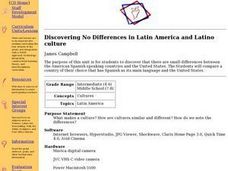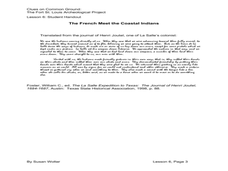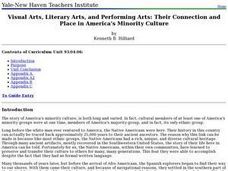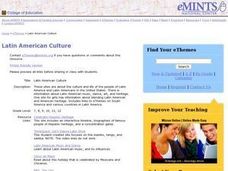Baylor College
What Is a One Part Per Million Solution?
Water may appear to be crystal clear, but there could be dissolved substances present. Lab groups make a one-part-per-million of a food coloring solution to demonstrate this concept. As part of an outstanding unit about water, this...
Baylor College
Heart and Lungs
With a partner, youngsters measure their pulse and breathing rates, both at rest and after running in place for a minute. While this activity is not novel, the lesson plan includes a large-scale classroom graphing activity and other...
Baylor College
Dust Catchers
In class, your emerging environmentalists construct dust catchers. They take them home for a week or two, and then bring them back into class to examine under a magnifier. From this activity, they learn what makes up dust and that...
Baylor College
Moving Air
In lab groups, young scientists place aluminum cans with a bubble-solution cap into different temperatures of water to see what size of bubble dome forms. As part of an atmosphere unit in preparation for learning about convection...
Curated OER
Discovering No Differences in Latin America and Latino Culture
Students explore the differences between American Spanish speaking countries and the United States. Students explore the history and culture of Spanish speaking countries. They examine Latino influences. Students create a presentation...
Curated OER
Mesoamerica: The History of Central America
Young scholars examine the role of women in Mesoamerica. They watch segments of the Discovery video "Mesoamerica: The History of Central America". After conducting further research pertaining to specific Mayan women, they write essays...
Curated OER
Drake’s West Indian Voyage 1588-1589
Learners examine the exploration routes of Sir Francis Drake. In this American exploration lesson, students investigate primary sources to trace the routes and contact with the natives that Sir Francis Drake experienced on his voyages in...
Curated OER
It’s a Big, Big World
Students examine the role of the explorers. In this explorers and conquistadors, students create word puzzles (Wordles) regarding the time period in history. Students conduct research regarding a particular explorer and create foldables...
Curated OER
Lesson 6: Examining Events from Different Perspectives Friend or Foe?
Fifth graders sequence events of European exploration and colonization by creating timelines. They define the differences between primary and secondary sources. They discuss claims to Texas land in the 17th Century.
Curated OER
Finding James Fort
Welcome to Jamestown! Third and fourth graders read and analyze primary source documents about Jamestown or Fort James. They read and analyze descriptions of Fort James from primary sources. They access a website to explore more...
Curated OER
What is a Hero? Heroism in Greek Mythology
Students explore the tales of Greek mythology and discuss what it means to be a hero. They associate acts of epic heroism with philanthropy noting that these characters acted in a larger than life manner to secure the common good.
Curated OER
Visual Arts, Literary Arts, and Performing Arts: Their Connection and Place in America's Minority Culture
Pupils explore the rich, varied, and full artistic culture of each of these three minority groups, Native Americans, Chicanos, and African Americans. They explore art through dance, music, literature, and many other different mediums....
Curated OER
Marquette and Joliet Explore the Mississippi in 1673
Students locate and name the St. Lawrence River, the five Great Lakes, and the Mississippi River on a modern map. They find Quebec, Michilimackinac, Wisconsin, and Chicago on that map. They find the same places on a 1681 map.
Baylor College
What's Is Soil Made Of?
It's time to roll up those sleeves and get a little dirty in the second lesson of this series on the science of food. Investigate where plants and animals get the minerals they need to live in this two-part exploration of soil. First,...
Baylor College
Why Is Water Important? Pre-assessment
This water worksheet is just the tip of the iceberg! It a multiple-choice quiz meant to be a pre-assessment for a wonderful water unit. There are 10 questions to be answered regarding the role, properties, and behavior of water. Make...
Baylor College
Bio Build-up
Trace pollutants through the environment in the seventh lesson of this series on the science of food. Looking at a picture of the plants and animals in an aquatic ecosystem, learners use dot stickers to represent harmful chemicals as...
Baylor College
What's That Food?
Get things cooking with the first lesson in this series on the science of food. Working in small groups, young scientists make and record observations about different mystery foods. These descriptions are then shared with the class and...
Baylor College
Healthy Snacks
Assess your pupils' ability to identify healthy food choices in the final lesson of this series on food science. Given five different food labels, young nutritionists will rank them from most to least healthy, supporting their choices...
Baylor College
Lungometer
Life science learners construct lung-o-meters from gallon-sized milk jugs and then measure their lung capacities. For older students, have them graph the vital lung capacities of each person in the class. Cross-curricular pieces are...
Baylor College
What is Air? Pre-Assessment
First, estimate existing knowledge about air with a class discussion. Then, hand out a 10-question pre-assessment quiz to record how much pupils know to compare to their knowledge later. This will also give mini meteorologists the...
Curated OER
California Indians
Fourth graders discuss the major nations of California Indians, their geographic distribution, economic activities, legends and religious beliefs. They describe the function of Spanish missions and the influence of Catholicism. In...
Curated OER
European Explorers
Students research one of seventeen explorers before filling in a worksheet. Next, they write a song verse using the information and sing it to the tune of "Row, Row, Row Your Boat." On the next day, they play a game of "Who Am I?" using...
Curated OER
Latin American Culture
Students explore sites are about the culture and life of the people of Latin America and Latin Americans in the United States. There is information about Latin American music, dance, art, and heritage.
Curated OER
Hispanic Arts and Culture Unit: Visual Arts, Dance, and Music
Learners learn about Latin American dance and rhythm in different forms and participate in dancing. In this Latin American lesson plan, students also analyze Latin American paintings.

























